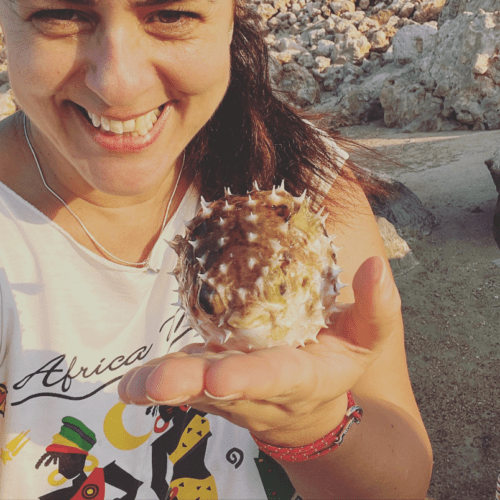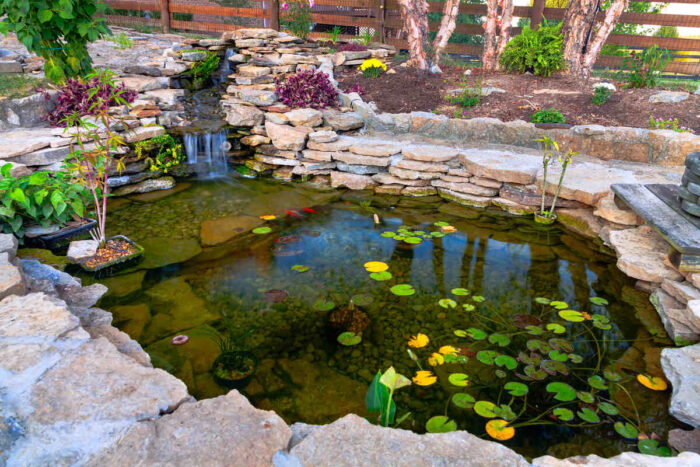Maintaining a koi pond is a rewarding endeavor, but it requires consistent effort and knowledge to keep the water clear and the fish healthy. In this article we talk about 10 Tips for Keeping Your Koi Pond Clean and Healthy.
Table of Contents
Size Up Your Filtration
Robust filtration is the cornerstone of every crystal clear koi pond. These systems mechanically remove debris, biologically process waste, and chemically polish water—all critical to maintaining pristine conditions.
We recommend investing in a filtration system rated for at least twice the volume of your pond. For example, if you have a 500-gallon pond, choose a 1,000 GPH or higher-rated system. This ensures the filter can readily keep pace with waste production.
Just as importantly, be diligent about cleaning and replacing filter media per the manufacturer’s recommendations. Clogged media severely reduces system efficiency.
Stay on Top of Your Water Parameters
Fluctuations in water chemistry can quickly stress fish or trigger algae blooms. That’s why we advise pond owners to test pH, ammonia, nitrite, and nitrate weekly.
Ideally, pH should hover between 7.2-7.6, while ammonia and nitrites should measure at zero ppm. Nitrates should remain under 40 ppm. Significant deviations warrant water changes and troubleshooting to get parameters back on track.
User-friendly all-in-one test strips make monitoring chemistry a breeze. Just be sure to follow the instructions carefully each time for consistent results.
Strategically Place Plants
Live plants act as the lungs of your pond, absorbing nutrients, providing shade, oxygenating water, and limiting algae growth. For best results, incorporate a mix of marginal and submerged vegetation.
Marginal plants like iris, taro, and canna lilies reside at the pond’s edges, where they filter surface runoff. Submerged plants such as anacharis, hornwort, and water lettuce cleanse deeper waters.
Position plants where they’ll receive sufficient sunlight for photosynthesis but also shade parts of the water to deter algae. Trimming back growth as needed and removing dead leaves prevents decay that fuels more algae.
Change Water Weekly
Even well-filtered, planted ponds benefit tremendously from regular water changes. Shoot to replace 10-15% of pond water weekly. This dilution keeps dissolved waste in check between more thorough monthly or quarterly cleanings (more below).
When refilling, make sure to dechlorinate and temperature match the new water. Chlorine burns fish gills, while drastic temperature shifts send fish into shock. Let the water sit 24 hours for gases to dissipate before adding.
Skim and Vacuum Regularly
No matter how robust your filtration, expect some debris to accumulate. Leaves, uneaten food, and other organic material that sinks to the bottom readily decay, degrading water quality.
Combat this by skimming the pond surface daily with a fine net. Remove anything captured before it sinks. Then every other week, vacuum the entire pond bottom using a designated siphon. This keeps sediment from building up.
Dispose of this debris in the trash or a compost pile—not back into the pond!
Fertilize and Groom Plants
Just like land plants, aquatics depend on nutrients from fish waste. But fertilization often becomes necessary, especially for heavy root feeders like water lilies or marginal plants in nutrient-poor soil.
Use pond tabs or liquid fertilizers to prevent mineral deficiencies that manifest as yellowed leaves or stunted growths. Always follow label directions carefully.
While fertilizing, prune back leggy stems, remove damaged foliage, and thin aggressive plants to maintain the ideal balance. This encourages healthy, manageable growth.
Feed Responsibly
It’s tempting to shower koi with food, but overfeeding mucks up water faster than anything. Stick to feeding only what they can completely finish within five minutes, once or twice daily.
Offer a spirulina-enhanced koi pellet or wheat germ diet to cover nutritional bases without excess protein. Cut back during colder months when metabolism slows.
Spreading out smaller meals prevents the sudden nutrient spikes that can trigger algae and oxygen crashes from uneaten food rotting.
Disinfect with UV
Green water usually results from microalgae that traditional filtration can’t trap. UV clarifiers destroy their DNA so they can’t reproduce. Water passes through a chamber surrounded by special UV bulbs, exiting cleansed.
Size your UV to pump capacity for maximum effectiveness. A too-small or old UV won’t eradicate algae fast enough. Replace bulbs every 10-12 months when output declines.
Run UV clarifiers continuously through summer months when algae growth peaks. Shut off in winter to conserve energy when not needed.
Stay Vigilant About Fish Health
Keeping a close eye out for signs of disease allows early diagnosis and treatment. Learn what normal, healthy fish look like so you can recognize when something seems off.
Pay attention for flashing, labored breathing, frayed fins, white spots, reddening, bloating, or odd growths. Also note any changes in behavior—especially decreased appetite or activity. Don’t ignore symptoms hoping they go away.
Consult a fish veterinarian for proper diagnosis and medication if concerned. Treating early boosts recovery odds exponentially.
Tailor Care to Seasons
Koi pond maintenance shifts with seasons, as environmental conditions drive changes. Heed this season-by-season breakdown for peak water quality all year long:
Spring: Ramp up feeding as metabolism increases. Clean pumps and change filter media preparing for summer. Conduct any necessary repairs before fish become active.
Summer: Monitor water quality vigilantly to stay ahead of algae. Consider installing a chiller if temps exceed 75°F. Clean UV clarifiers and change bulbs if needed.
Fall: Handle falling leaves right away before they sink and decompose. Cover pond with protective netting to catch future debris. Stop feeding when temps drop below 50°.
Winter: Run pumps and filters year-round in cold climates to prevent freezing. Maintain at least a 3×3 foot opening unfrozen for gas exchange.
Stay Diligent For Healthy, Happy Koi
While establishing proper pond conditions takes some initial investment, maintaining the system simply requires regular attention and care. Devote just 30-60 minutes per week and you’ll enjoy crystal clear water and healthy koi for years on end. I sincerely hope you find this “10 Tips for Keeping Your Koi Pond Clean and Healthy” article helpful.

Marta, the driving force behind WaterWorldCraze.com, holds a Master’s degree in Marine Biology and has extensive experience in water sports and activities. With over 7+ years of hands-on experience in marine research and conservation, she has participated in numerous underwater expeditions and projects. Her passion for the aquatic world shines through in her expertly curated content. Join Marta as she explores the wonders of marine life and shares her adventures. Connect with her on Instagram @marinebiologymarta for more insights and updates.

